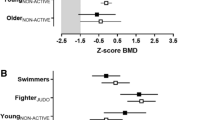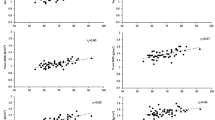Abstract
Summary
Most researchers adjust bone by lean mass when comparing swimmers with controls. This adjustment is done under the assumption that lean affects bone similarly in both groups. Nonetheless, we found that the muscle-bone association is uncoupled in swimmers, and consequently, researchers should avoid this adjustment when evaluating swimmers’ bone.
Introduction
To examine the functional and structural muscle-bone unit in adolescent swimmers.
Methods
Sixty-five swimmers (34 girls/31 boys) and 119 controls (51 girls/68 boys) participated in the study. Muscle cross-sectional area (MCSA), bone mineral content (BMC), and polar strength-strain index (SSIPOL) were measured in the non-dominant radius by peripheral quantitative computed tomography (pQCT). Subtotal BMC and lean mass were evaluated with dual-energy X-ray absorptiometry (DXA). Handgrip and isometric knee extension (IKE) tests were performed to determine muscle force. The effect of MCSA, lean and force on SSIPOL, and BMC were tested, and the functional and structural muscle-bone ratios of swimmers and controls were compared.
Results
Both muscle size (MCSA and lean) and muscle force (handgrip and IKE) influenced BMC and SSIPOL in swimmers and controls similarly. Swimmers presented normal MCSA and lean values for their height, but when compared with controls, swimmers presented a higher amount of lean and MCSA for the same BMC or SSIPOL (structural muscle-bone unit). For the functional muscle-bone unit, different results were found for the lower and upper limbs, as no differences were found for the upper limbs, while for the lower limbs, swimmers presented higher muscle force for the same amount of BMC.
Conclusions
The contradictory results regarding BMC in swimmers found in previous studies could partly be explained with the findings of the present study that reinforce the idea that swimming is not an effective sport to practice regarding bone mass and that the muscle-bone unit is different in swimmers than in controls.
Similar content being viewed by others
References
Weaver CM, Gordon CM, Janz KF, Kalkwarf HJ, Lappe JM, Lewis R, O’Karma M, Wallace TC, Zemel BS (2016) The National Osteoporosis Foundation’s position statement on peak bone mass development and lifestyle factors: a systematic review and implementation recommendations. Osteoporos Int 27:1281–1386
Gomez-Bruton A, Gonzalez-Aguero A, Gomez-Cabello A et al (2013) Is bone tissue really affected by swimming? A systematic review. PLoS One 8:e70119
Olmedillas H, Gonzalez-Aguero A, Moreno LA et al (2012) Cycling and bone health: a systematic review. BMC Med 10:168
Burr DB (1997) Muscle strength, bone mass, and age-related bone loss. J Bone Miner Res 12:1547–1551
Gómez-Bruton A, González-Agüero A, Gómez-Cabello A, Matute-Llorente A, Casajús JA, Vicente-Rodríguez G (2015) The effects of swimming training on bone tissue in adolescence. Scand J Med Sci Sports 25:e589–e602. https://doi.org/10.1111/sms.12378
Gomez-Bruton A, Montero-Marín J, González-Agüero A, García-Campayo J, Moreno LA, Casajús JA, Vicente-Rodríguez G (2016) The effect of swimming during childhood and adolescence on bone mineral density: a systematic review and meta-analysis. Sports Med 46:365–379. https://doi.org/10.1007/s40279-015-0427-3
Schoenau E, Neu CM, Beck B, Manz F, Rauch F (2002) Bone mineral content per muscle cross-sectional area as an index of the functional muscle-bone unit. J Bone Miner Res 17:1095–1101
Anliker E, Toigo M (2012) Functional assessment of the muscle-bone unit in the lower leg. J Musculoskelet Neuronal Interact 12:46–55
Ireland A, Maden-Wilkinson T, McPhee J et al (2012) Upper limb muscle-bone asymmetries and bone adaptation in elite youth tennis players. Med Sci Sports Exerc 45:1749–1758
Calbet JA, Moysi JS, Dorado C, Rodriguez LP (1998) Bone mineral content and density in professional tennis players. Calcif Tissue Int 62:491–496
Schoenau E (2005) The “functional muscle-bone unit”: a two-step diagnostic algorithm in pediatric bone disease. Pediatr Nephrol 20:356–359
Gomez-Bruton A, Gonzalez-Aguero A, Gomez-Cabello A et al (2015) Bone structure of adolescent swimmers; a peripheral quantitative computed tomography (pQCT) study. J Sci Med Sport 19:707–712
Veilleux L-N, Pouliot-Laforte A, Lemay M, Cheung MS, Glorieux FH, Rauch F (2015) The functional muscle–bone unit in patients with osteogenesis imperfecta type I. Bone 79:52–57. https://doi.org/10.1016/j.bone.2015.05.019
Soucek O, Matyskova J, Anliker E, Toigo M, Hlavka Z, Lebl J, Sumnik Z (2015) The muscle–bone interaction in Turner syndrome. Bone 74:160–165. https://doi.org/10.1016/j.bone.2015.01.017
Tanner JM, Whitehouse RH, Takaishi M (1966) Standards from birth to maturity for height, weight, height velocity, and weight velocity: British children, 1965. II. Arch Dis Child 41:613–635
Leone M, Comtois AS (2007) Validity and reliability of self-assessment of sexual maturity in elite adolescent athletes. J Sport Med Phys Fit 47:361–365
Marfell-Jones M, Olds T, Stewart A, Carter L (2006) International standards for anthropometric assessment. International Society for the Advancement of Kinanthropometry (ISAK), Potchefstroom
Ruiz JR, Espana-Romero V, Ortega FB et al (2006) Hand span influences optimal grip span in male and female teenagers. J Hand Surg Am 31:1367–1372
Gomez-Bruton A, González-Agüero A, Casajus JA, Vicente-Rodríguez G (2014) Swimming training repercussion on metabolic and structural bone development. Benefits of the incorporation of whole body vibration or pilometric training. The RENACIMIENTO project. Nutr Hosp 30:399–409
Schiessl H, Ferretti JL, Tysarczyk-Niemeyer G, Willnecker J (1996) Noninvasive bone strength index as analysed by peripheral quantitative computed tomography (pQCT). In: Schoenau E (ed) Paediatric osteology: new developments in diagnostics and therapy. Elsevier, Amsterdam, The Netherlands, pp 141–146
Schoenau E, Neu CM, Mokov E, Wassmer G, Manz F (2000) Influence of puberty on muscle area and cortical bone area of the forearm in boys and girls. J Clin Endocrinol Metab 85:1095–1098
Jurimae J, Cicchella A, Tillmann V et al (2009) Effect of pubertal development and physical activity on plasma ghrelin concentration in boys. J Endocrinol Investig 32:18–22
Ferry B, Lespessailles E, Rochcongar P, Duclos M, Courteix D (2013) Bone health during late adolescence: effects of an 8-month training program on bone geometry in female athletes. Jt Bone Spine 80:57–63
Hagman M, Helge EW, Hornstrup T, Fristrup B, Nielsen JJ, Jørgensen NR, Andersen JL, Helge JW, Krustrup P (2018) Bone mineral density in lifelong trained male football players compared with young and elderly untrained men. J Sport Health Sci 7:159–168. https://doi.org/10.1016/J.JSHS.2017.09.009
Lozano-Berges G, Matute-Llorente Á, González-Agüero A, Gómez-Bruton A, Gómez-Cabello A, Vicente-Rodríguez G, Casajús JA (2017) Soccer helps build strong bones during growth: a systematic review and meta-analysis. Eur J Pediatr 177:295–310. https://doi.org/10.1007/s00431-017-3060-3
Burt LA, Greene DA, Ducher G, Naughton GA (2013) Skeletal adaptations associated with pre-pubertal gymnastics participation as determined by DXA and pQCT: a systematic review and meta-analysis. J Sci Med Sport 16:231–239
Tenforde AS, Fredericson M (2011) Influence of sports participation on bone health in the young athlete: a review of the literature. PM&R 3:861–867
Guadalupe-Grau A, Fuentes T, Guerra B, Calbet JA (2009) Exercise and bone mass in adults. Sports Med 39:439–468
Meakin LB, Price JS, Lanyon LE (2014) The contribution of experimental in vivo models to understanding the mechanisms of adaptation to mechanical loading in bone. Front Endocrinol 5:154
Robling AG, Burr DB, Turner CH (2000) Partitioning a daily mechanical stimulus into discrete loading bouts improves the osteogenic response to loading. J Bone Miner Res 15:1596–1602
Hawkins SA, Schroeder ET, Wiswell RA et al (1999) Eccentric muscle action increases site-specific osteogenic response. Med Sci Sports Exerc 31:1287–1292
Author information
Authors and Affiliations
Corresponding author
Ethics declarations
Study design, protocol, and consent forms were performed in accordance with the Helsinki Declaration of 1964 (revised in Fortaleza, 2013) and were reviewed and approved by the Research Ethics Committee of the Government of Aragon (ref. CP08/2012, CEICA, Spain).
Conflicts of interest
None.
Additional information
Publisher’s note
Springer Nature remains neutral with regard to jurisdictional claims in published maps and institutional affiliations.
Electronic supplementary material
ESM 1
(DOCX 47 kb)
Rights and permissions
About this article
Cite this article
Gomez-Bruton, A., Gonzalez-Aguero, A., Matute-Llorente, A. et al. The muscle-bone unit in adolescent swimmers. Osteoporos Int 30, 1079–1088 (2019). https://doi.org/10.1007/s00198-019-04857-3
Received:
Accepted:
Published:
Issue Date:
DOI: https://doi.org/10.1007/s00198-019-04857-3




